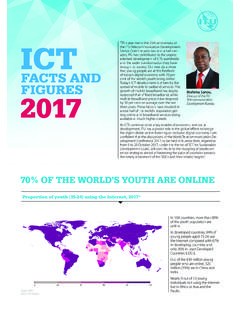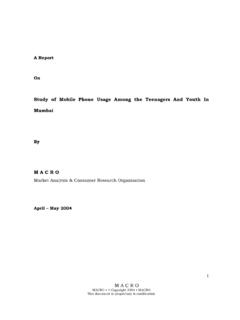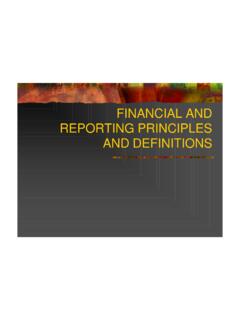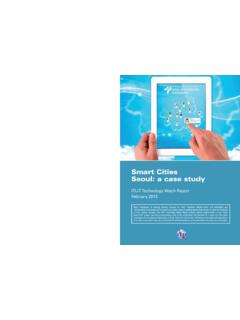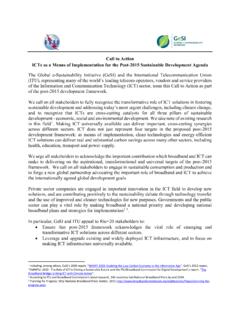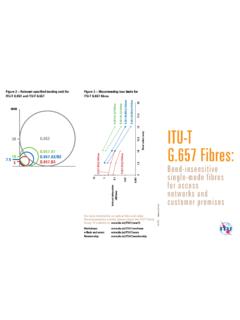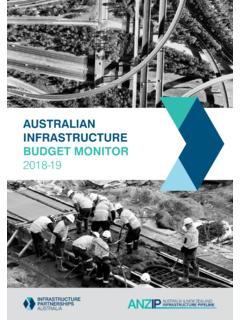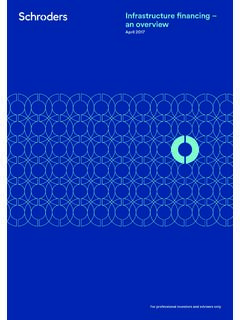Transcription of Key features and requirements of 5G/IMT-2020 networks
1 ITU Arab Forum on Emerging Technologies Algiers Algeria, 14-15 Feb. 2018. Key features and requirements of 5G/IMT-2020 networks Presented by: Marco Carugi, ITU expert ITU-T Q2/13 Associate Rapporteur and SG13 Mentor Outline Distinguishing features of 5G/IMT-2020 networks High level requirements of 5G/IMT-2020 networks NOTE 1 Only a limited set of topics is addressed (see [ITU-T ] for a wider perspective). NOTE 2 Along the presentation some references are provided on relevant achievements and ongoing work items of the ITU-T IMT-2020 standardization initiative (SG13) - see also backup slides Gaps and challenges towards 5G/IMT-2020 . Peak Data Rate User Experienced [Gb/s] Data Rate [Mb/s]. 20. 100. Enhanced mobile broadband (eMBB) IMT-2020. 10. 1. Traffic Capacity IMT- Spectrum 2 Advanced [Mbit/s/m ] Efficiency 10-100 1 3x 1x 1x 10x 100 x 350 Mobility Network Energy 500 [km/h]. Efficiency Ultra-reliable and low Massive machine type latency mobile 10.
2 5 10. communications communications (mMTC)Connection (URLLC). 10. 6 1. Density Latency 2. [devices/km ] [ms]. NB: Downlink metrics shown Source: NGMN 5G White Paper Other network dimensions with gaps for 5G/IMT-2020 expectations: - business agility (diversity of services and business models). - operational sustainability (end-to-end management and deployment, flexibility, scalability, energy efficiency). 3. 5G/IMT-2020 as key driver for industrial and societal changes: enabler of a large variety of applications Source: Ofcom Source: 5G Infrastructure Association, 5G Empowering vertical industries, White Paper Optimization and/or expansion of existing applications (extended coverage, enhanced features ). 5. New applications (verticals and advanced applications enabled by technology integration). Diverse application-specific requirements to be supported Network islands of Gigabit/s Widening of current communications communication use cases Low cost connectivity for huge number of devices Critical & low latency communications Flexible networks Source: ITU-R Rec.
3 5G/IMT-2020 objective: to ensure flexibility and adaptation to diverse (and changing) requirements of applications with maximum reusability of (common) network infrastructure capabilities and efficient but open integration between application and 5G/IMT-2020 ecosystem (business models diversity). 6. 5G/IMT-2020 vision - functional view Softwarization Flexibility Customization Service-based architecture and MM SM Policy CP functions interaction 5G New Radio Modularization of functions Separation between Control Evolved LTE NRF AU UDM AF Plane (CP) and User Plane (UP). Network Slicing Fixed Access Flexible User Plane Fixed Mobile Convergence WLAN. UP (local) UP (central) UP (through converged Control Diversity of Access Network Technologies Source: China Mobile Plane and simplified User Plane). 8. Network softwarization Network softwarization [ ]: Overall approach for designing, implementing, deploying, managing and maintaining network equipment and/or network components by software programming Key drivers of Network softwarization o pervasive diffusion of ultra-broadband (fixed and mobile) Softwarization embedded o increase of performance of HW at lowering costs o growing availability of Open Source SW NFV across all network layers SDN.
4 By leveraging SDN, NFV, o more and more powerful terminals and smart things Edge and Cloud Computing o actionable Big Data and AI/ML advances Edge and Cloud Network softwarization is paving the way towards X-as-a-Service Computing o SDN Controllers, Virtual Network Functions and end users' applications all considered as services . Network functions become flexible o New components can be instantiated on demand ( dedicated network dynamic setup). o Components may change location or size ( deployment at edge nodes, resource reallocation). o Communication paths may change ( service aware networking, chained user plane functions). Enablement of network/service architectures (re-)design, cost and process optimization, self-management Network programmability but also increased complexity [network management impact]. See also ITU-T Network Functions Virtualization (NFV): ICT ecosystem disruption NFV is about implementing network functions in software (programs) running on top of industry- standard hardware (instead of dedicated hardware).
5 NFV benefits Network Functions Classical Network Appliance Approach Virtualisation Approach o Reduced CAPEX and OPEX ( Open Ecosystem Competitive &. power consumption) WAN Independent Innovative Acceleration o Increased efficiency (several CDN Session Border Software Vendors Message Controller tenants on same infrastructure) Router o Flexibility to scale up/down resources DPI Firewall Carrier Grade NAT. Tester/QoE Automatic orchestration and monitor o Agility (improved time-to-market remote installation High volume standard servers to deploy new network services). o Lower dependency on network SGSN/GGSN PE Router BRAS Radio/Fixed Access Network Nodes High volume standard storage vendors Fragmented, purpose-built hardware Physical install per appliance per site Hardware development: large barrier to entry for new vendors, constraining innovation & competition High volume Ethernet switches Some issues to be fully addressed, incl.
6 Performance, co-existence, resilience, scalability, vendor integration 10. Software Defined Networking (SDN). SDN is a set of techniques enabling to directly program, control and manage network resources, which facilitates design, delivery and operation of network services in a dynamic and scalable manner. SDN benefits o Faster network business cycle Open Interfaces o Acceleration of innovation and rapid adaptation to demand Network services o Increase in resource availability and efficiency of use Open Interfaces o Customization of network resources including service-aware networking Concept of SDN. [Source: ITU-T ]. 11. Separation between Control Plane and User Plane Authentication Access Control Authentication Access Control Charging SM. o Scalability Charging MM MM. Policy o Independent evolution Policy SM of both planes Control plane entity o Flexible network Packet Forwarding Packet Forwarding function deployment Legacy NW entity User plane entity CP.
7 Open interfaces (in accordance with SDN principles). UP UP UP. Different User Planes under control of a unified Control Plane 12. Edge Computing: computing and storage resources next to the user Low latency applications LTE Autonomous Devices Edge Cloud/Compute Core Peering Internet Drones Self-Driving Cars Robotics Content &. Logic WiFi Content &. Logic Immersive Experiences reduced latency through Edge Computing Interactive Environments network Virtual Reality latency Augmented Reality Edge Computing benefits Natural Interfaces o (Ultra-)low latency: disruptive improvement of customer Voice Control experience Motion Control Eye-Tracking o Reduction of backhaul/core network traffic: cloud services ( , big data) near to user [Ultra-low Latency < 20 ms]. o In-network data processing Edge Computing and more: Fog/Device Computing Some issues to be fully addressed, incl. Resource limitation, more complexity, inefficient application execution, service continuity and mobility 13.
8 A distributed functional architecture Distribution of network functions - example Provisioning of diverse network services by using network functions instantiated at the right place and time 14. Network slicing: customized support of applications via dedicated logical networks over single infrastructure Network slice [ITU-T ]: A logical network that provides specific network capabilities and network characteristics. Various dimensions of network slicing: o slice types and blueprint (template). o blueprint information (incl. service requirements , priority, resource isolation level, etc.). o static versus dynamic slice instantiation o service assurance and service integration o recursive slicing (diverse business models). o end-to-end versus per-domain slice (sub-network slices, incl. radio slicing), inter-domain slice federation Vertical and o per-slice network function chaining o slice-specific and shared network functions horizontal slicing o slice lifecyle mgt (within globally optimal network mgt).
9 O UE-slice interaction (flexible slice selection, ). o slice exposure of end-to-end slices to customers Network slice instances and network functions 5G/IMT-2020 network has to support flexible and dynamic management of network slices for various Slicing versus limitations of classical approaches ( All-in-One . diverse applications, ensuring scalability, high too complex, Multiple networks too costly). 15 availability and overall resource optimization Example of IMT-2020 network deployment from network slicing perspective Vertical slicing Horizontal slicing [can operate in single slice or across multiple vertical slices]. Source: draft ITU-T Each slice is architected and optimized for specific application(s). 16. Each slide can have its own network architecture, engineering mechanisms and network provision Application of slicing techniques to 5G/IMT-2020 . network transport layer - ongoing study in ITU-T SG15.
10 Source: China Mobile 17. Network management and orchestration Network slice lifecycle management: conceptual framework Softwarization impacts network management o New types of failure (underlying infrastructure, virtualization). o Dynamic deployment of components o Increased accounting options o Adaptation to required performances o Wider spectrum of attacks (cloud infrastructure, sharing). Overall network management and network slice lifecycle management Network slice lifecycle management: functional view o Level of isolation between network slices o Blueprint (Template) based network slices o Network slice-specific policies and configurations o Overall orchestration of physical and logical resources o Integrated management of legacy networks 18. Sources: ITU-T , Heterogenous Access networks and common Core Network Integration of existing and new Macro Cell Small Cells Access networks (ANs) (new RATs as well as evolved IMT-advanced RATs, Lower Micro-wave Higher Micro- Wireless LANs, fixed broadband, satellite).
